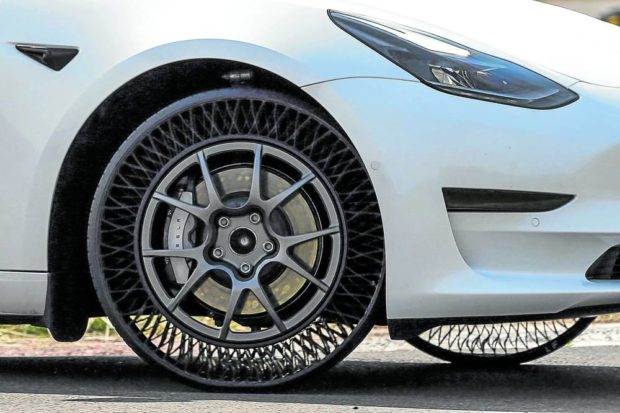
HITTING ROADS SOON | Airless tires can last the entire lifetime of most cars but face the gargantuan challenge of supporting the weight of the car and absorbing shocks as well as standard tires filled with air for thousands and thousands of kilometers. (Agence France-Presse)
COLMAR-BERG, Luxembourg — Airless tires that never go flat or need to be inflated: It’s a decades-long dream that manufacturers hope to turn into a reality soon, but for truck drivers first.
The challenges that the technology faces were put on display at a Goodyear test track in Luxembourg, where a group of journalists put a Tesla equipped with airless tires through its paces.
Instead of being filled with air, the tires have a web of spokes that keeps the wheels firm and gives them a see-through look.
The thin layer of rubber gripping the asphalt has a gargantuan physical challenge to meet: supporting the weight of the car and absorbing shocks as well as standard pneumatic tires for thousands of kilometers.
That challenge is being overcome: the tire’s rubber and plastic structure resisted the huge stress as the car banked into the track’s tight turns.
The ride is smooth but the grip is not as good as on conventional tires—and they are noisier.
The tires were tested for 120,000 kilometers at speeds of up to 160 kph in both scorching temperatures as well as snow, said Michael Rachita, who heads Goodyear’s efforts to develop airless tires.
“The most obvious advantage is that it’s puncture-proof,” said Rachita. “It will never run flat, you could drive over any nail and expect not to lose performance.”
He said the tires will also be maintenance-free, as drivers will never need to check and adjust air pressure.
A second generation of airless tires that are lighter, quieter, and roll better are in the works, Rachita said.
Gradual transition seen
Michelin has released the Tweel, but it is for construction vehicles rather than cars where the demand in terms of driving performance is much greater.
The French firm has also unveiled the Uptis which it is developing with US car manufacturer General Motors, and which it hopes can make the jump from auto shows to showrooms next year.
Its researchers are working on a cocktail of fiberglass and resin to hold the rubber onto the honeycomb structure of the new tire.
But Michelin’s CEO Florent Menegaux doesn’t expect airless tires to squeeze out regular tires anytime soon.
“We’re going to continue to have air tires for several decades,” he said.
Nevertheless, Goodyear, which submitted its first patent on airless tire technology in 1982, has recently been gearing up in research and development.
The US firm aims to have a maintenance-free and long-lasting airless tire for cars by the end of the decade.
It already has an early version for shuttle buses and automated delivery vehicles on university campuses.
Skeptical
Bridgestone also hopes to have an airless tire ready in a decade, having already tested early versions on utility vehicles.
But other manufacturers are more skeptical that airless tires will ever offer comparable shock absorption as traditional tires, with the noise reduced sufficiently.
“They aren’t a viable solution and I don’t expect they will become one,” a Continental researcher, Gerrit Bolz, said at a tire convention in 2017.
Independent researcher Ulf Sandberg at the Swedish National Road and Transport Research Institute, which is working on an airless tire for trucks, believes it will eventually become a viable alternative.
“I believe that sooner or later airless tires could take over,” he said.